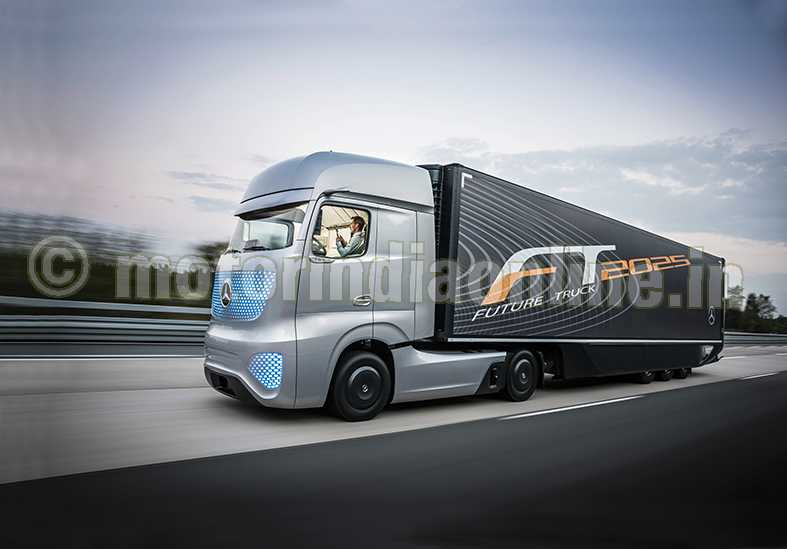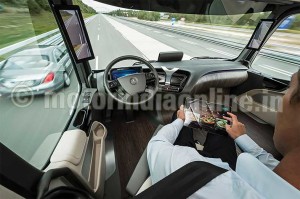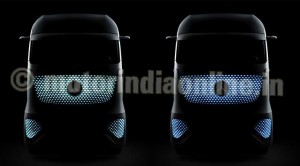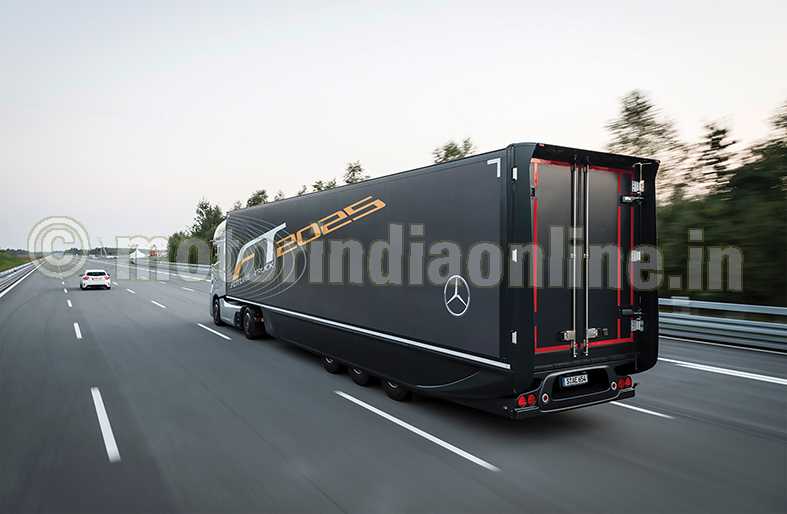The new innovation benchmark
A dream comes true! The spectacular Mercedes-Benz Future Truck 2025 provides a visually exciting and technically feasible take on the long-distance truck of tomorrow. The futuristic vehicle comes with a string of amazing innovations and new technologies which are set to change the way the world trucks, come 2025. The technology of tomorrow is already a reality at Daimler Trucks through the Mercedes-Benz Future Truck 2025, which constitutes a revolution in efficiency, safety and networking, a revolution for road traffic and its infrastructure, for professional driving and for the entire road transport sector.
The technology behind the Future Truck is impressive indeed. The Mercedes-Benz Future Truck 2025 is not, for instance, part of a platoon. It does not need to be daisy-chained to other vehicles either. Radar sensors and camera technology enable the Future Truck to drive autonomously, independently of other vehicles or central control stations. Its technical features are thus crucial in giving the truck its outstanding capabilities as an autonomous vehicle. For Mercedes-Benz the culmination of this is the highly intelligent “Highway Pilot” system, which resembles the autopilot on an aircraft. Networking with other trucks or passenger cars extends its abilities further, but is not necessary for autonomous driving.
A radar sensor in the lower area of the front end scans the road ahead at long and short range. The front radar sensor has a range of 250 m and scans an 18-degree segment. The short-range sensor has a range of 70 m and scans a 130-degree segment. The radar sensor is the basis for the proximity control and emergency braking safety systems already available today.
A stereo camera installed above the instrument support behind the windscreen keeps the area ahead of the vehicle in view. This is currently the location of a mono-camera if optional Lane Keeping Assist is ordered. The range of the stereo camera is 100 m, and it scans an area of 45 degrees horizontally and 27 degrees vertically.
The stereo camera of the Mercedes-Benz Future Truck 2025 identifies single- or two-lane roads, pedestrians, moving and stationary objects, all objects within the monitored area and also the road surface. The camera recognises everything that contrasts with the background, and is therefore also able to measure clearances precisely. The front stereo camera also registers the information on traffic signs.
In addition to object and distance recognition, the stereo camera recognises lane markings as a major function for autonomous lane guidance.
These sensors form the heart of the new Blind Spot Assist system from Mercedes-Benz. The radar sensor modules are arranged in such a way that they cover the area parallel to the truck over the entire length of a tractor-trailer combination or drawbar combination. In addition, this strip is extended forwards to two metres in front of the truck.
Blind Spot Assist warns the truck driver about other road users not only when turning; it also warns about imminent collisions with stationary obstacles – for example, signs or lamps – and serves as an assistance system when changing lanes.
Networked and autonomous
All sensors on board the Future Truck 2025 are networked (multi-sensor fusion) and provide a complete image of the surroundings. All moving and stationary objects in the truck’s vicinity are registered.
Fusion of the data by a high-performance multi-core processor in the central computer links the data from all sensors in the whole area in front of and beside the truck.
The sensor and camera technology is active from standstill to the legally permitted maximum speed for trucks. By intervening in the steering, it automatically keeps the truck safe in the centre of its lane. The system also includes a three-dimensional digital map, which is already used for the assistance system Predictive Powertrain Control (PPC). This means that the truck is always fully aware of the road’s course and topography.
V2V and V2I communication
The “Highway Pilot” is ideally partnered with V2V and V2I networking. Every vehicle equipped with this in the near future will transmit continuous information to its surroundings. This includes vehicle position and model, dimensions, direction of travel and speed, any acceleration and braking manoeuvres and the bend radii negotiated.
The frequency of information transfer depends on the vehicle speed and the intensity of any changes in its movement. It varies between one message per second when cruising to ten times this interval when changes are significant.
Transmission is via WLAN technology, using the standard Europe-wide G5 frequency of 5.9 gigahertz. The basis is the ITS Vehicle Station (Intelligent Transport Systems and Services) on board the vehicle.
Communication between vehicles is also standardised. The range of these continuously sent messages is a radius of around 500 m. The vehicles inform each other about their movements, so that they can respond to them immediately in anticipatory mode. This includes reacting to vehicles joining a motorway, or when approaching the end of a traffic tailback, for example. The more vehicles are communicating with each other on these routes, the more dynamically and flexibly they are able to respond to one another and together.
In an ideal scenario, an uninterrupted chain of communication forms along a route that rigorously informs the driver and vehicle about road and traffic conditions a long way ahead on their journey.
V2I means that all these messages and signals are also sent to external recipients such as traffic control centres. These are then able to respond flexibly, for example by changing the speed limit or opening up additional lanes. Messages can also be sent to vehicles, for example about temporary roadworks.
All these data inform the driver and the onboard computer about events happening outside the range of vision in good time. The driver and the vehicle are therefore aware of obstacles in advance, before they can become a hazard.
Anti-tailback measures
The Mercedes-Benz Future Truck 2025 is therefore not on the road in isolation, but constantly communicates with its environment, unnoticed by the driver.
All traffic information are passed on in this way and the data become available to all road users. Because networked vehicles respond automatically to these data, homogeneous traffic flow is ensured along with exceptional utilisation of the limited road infrastructure. In combination with autonomous driving, road traffic will develop into a self-learning system.
The average speed is thus improved by better traffic flow alone and without raising the maximum speed. At the same time, homogeneous traffic saves fuel.
One of the most interesting questions on the subject of autonomous driving is the time horizon envisaged for its realisation. In purely technical terms, turning it into reality on the roads is already feasible within around five years. In terms of passenger car development cycles, a possible start is envisaged in 2020. Owing to the more complex factors for heavy commercial vehicles, the time horizon for such vehicles will, however, be rather longer – realistically implementation is possible within ten years, also in view of the legal considerations that still remain to be clarified.
The introduction of autonomous driving will not happen digitally from one day to the next, as development is taking place in a gradual manner: evolutionary stages are necessary to revolutionise goods haulage on the roads. In the coming years, new and improved assistance systems will continue to pave the clearly set-out way for autonomous driving.



